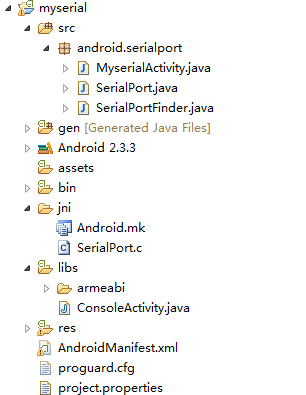編輯:關於Android編程
在看相關PackageManager代碼時,無意中發現Android 下提供一個pm命令,通常放在/system/bin/下。這個命令與Package有關,且非常實用。所以研究之。
usage: pm [list|path|install|uninstall]
pm list packages [-f]
pm list permission-groups
pm list permissions [-g] [-f] [-d] [-u] [GROUP]
pm list instrumentation [-f] [TARGET-PACKAGE]
pm list features
pm path PACKAGE
pm install [-l] [-r] [-t] [-i INSTALLER_PACKAGE_NAME] [-s] [-f] PATH
pm uninstall [-k] PACKAGE
pm enable PACKAGE_OR_COMPONENT
pm disable PACKAGE_OR_COMPONENT
pm setInstallLocation [0/auto] [1/internal] [2/external]
The list packages command prints all packages. Options:
-f: see their associated file.
The list permission-groups command prints all known
permission groups.
The list permissions command prints all known
permissions, optionally only those in GROUP. Options:
-g: organize by group.
-f: print all information.
-s: short summary.
-d: only list dangerous permissions.
-u: list only the permissions users will see.
The list instrumentation command prints all instrumentations,
or only those that target a specified package. Options:
-f: see their associated file.
The list features command prints all features of the system.
The path command prints the path to the .apk of a package.
The install command installs a package to the system. Options:
-l: install the package with FORWARD_LOCK.
-r: reinstall an exisiting app, keeping its data.
-t: allow test .apks to be installed.
-i: specify the installer package name.
-s: install package on sdcard.
-f: install package on internal flash.
The uninstall command removes a package from the system. Options:
-k: keep the data and cache directories around.
after the package removal.
The enable and disable commands change the enabled state of
a given package or component (written as “package/class”).
The getInstallLocation command gets the current install location
0 [auto]: Let system decide the best location
1 [internal]: Install on internal device storage
2 [external]: Install on external media
The setInstallLocation command changes the default install location
0 [auto]: Let system decide the best location
1 [internal]: Install on internal device storage
2 [external]: Install on external media
1.1:察看已安裝的包:
pm list package
此時則顯示所有已經安裝的包名。
pm list package -f
也顯示associated文件所在目錄(即保存的APK文件)
1.2:察看已知的權限組:
pm list permission-groups
1.3:察看所有已知的權限:
pm list permissions
1.4:列出所有硬件相關信息:
pm list features
結果通常類似:
feature:reqGlEsVersion=0x20000
feature:android.hardware.bluetooth
feature:android.hardware.camera
feature:android.hardware.location
feature:android.hardware.location.network
feature:android.hardware.microphone
feature:android.hardware.sensor.accelerometer
feature:android.hardware.sensor.compass
feature:android.hardware.touchscreen
feature:android.hardware.wifi
1.5:列出指定包名的 associated 文件 (APK存檔文件) 所在:
例如:
pm path com.TDiJoy.fane
package:/mnt/asec/com.TDiJoy.fane-1/pkg.apk
1.6: 安裝APK:
pm install [-l] [-r] [-t] [-i INSTALLER_PACKAGE_NAME] [-s] [-f] PATH
PATH 指 APK文件絕對路徑和文件名。
例如:
pm install /data/3dijoy_fane.apk
這幾個參數很有用:
-r: 安裝一個已經安裝的APK,保持其數據不變。
-i:指定安裝的包名。(沒試出來)
-s: 安裝到SDCard上。
-f: 安裝到內部Flash上。
1.7:卸載APK:
pm uninstall 包名。
例如:
pm uninstall com.TDiJoy.fane
1.8: 得到和設置缺省安裝位置:
The getInstallLocation command gets the current install location
0 [auto]: Let system decide the best location
1 [internal]: Install on internal device storage
2 [external]: Install on external media
The setInstallLocation command changes the default install location
0 [auto]: Let system decide the best location
1 [internal]: Install on internal device storage
2 [external]: Install on external media
pm getInstallLocation
得到缺省的安裝位置。
設置:
pm setInstallLocation <0|1|2>
0: 自動。
1:內部Flash。
2:擴展存儲設備。
實例:如何在海信2.2 STB上將APK安裝到U盤中:
Sam首先嘗試使用:
pm setInstallLocation 2
之後安裝之,沒有用。
後來做如下嘗試:
*在其它設置->存儲設備->制定默認存儲設備中選擇U盤為默認存儲設備。
# pm install -s xxxx.apk*
就可以成功。
 Android串口操作,簡化android-serialport-api的demo
Android串口操作,簡化android-serialport-api的demo
最近在做android串口的開發,找到一個開源的串口類android-serialport-api。其主頁在這裡http://code.google.com/p/andr
 Android圖像處理之霓虹濾鏡效果
Android圖像處理之霓虹濾鏡效果
霓虹是用來描繪圖像的輪廓,勾畫出顏色變化的邊緣,加強其過度效果,使圖像產生輪廓發光的效果。主要步驟為1、根據當前像素與其右方和下方像素的梯度運算;2、然後將結果值作為當前
 Android簡易實戰教程--第十四話《模仿金山助手創建桌面Widget小部件》
Android簡易實戰教程--第十四話《模仿金山助手創建桌面Widget小部件》
打開谷歌api,對widget小部件做如下說明:App Widgets are miniature application views that can be embed
 [Android UI]ActionBar隨ScorllView上下拖動而透明度漸變效果
[Android UI]ActionBar隨ScorllView上下拖動而透明度漸變效果
我看到越來越多的應用使用這樣的效果,如QQ空間5.0的主界面,確實很好看!大概就搜了一下相關的實現方式,發現早就有了相關的方案: 仿QQ空間滾動ActionBar透明度變